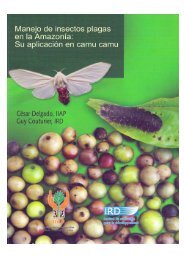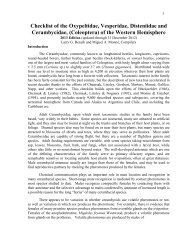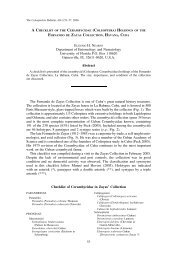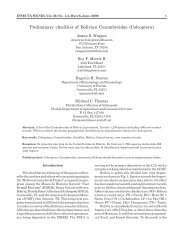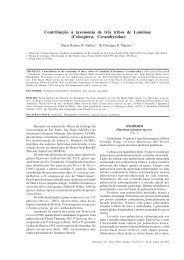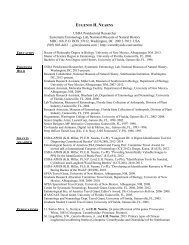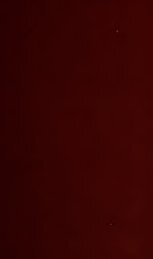You also want an ePaper? Increase the reach of your titles
YUMPU automatically turns print PDFs into web optimized ePapers that Google loves.
106 THE TRIBE ONClDERINI<br />
Elytra with sides nearly straight, tapering slightly to apices, which are separately<br />
rounded; basal gibbosity broad, feeble; entire basal one-fourth coarsely seriately<br />
granulate-punctate, granules evanescent after anterior quarter, the punctures con<br />
tinuing to middle and beyond middle tnwards suture, apical half finely and obso<br />
letely punetate; humeri slightly prominent, anterior margin arcuate, slighUy<br />
oblique, angle with a low tubercle from which runs a very short, feeble carina, its<br />
length about half that of anterior margin; sides with a row of fine punctures and<br />
on angle of declivity several irregularly placed coarse ones. Prosternum narrow,<br />
simple. Procoxae somewhat tumid posteriorly, in front armed with a broad, obtuse<br />
tubercle. (All six legs missing, except for coxae.) Fifth sternite three-fourths<br />
again as long as fourth; apex feebly obtUEe, distinctly tufted at middle, surface<br />
with a very shallow impression ncar tip. Antennae as long as body, finely fimbriate<br />
beneath to apex; scape slender, apical one-third slightly capitate, not rugose; third<br />
segment equal in length to first, visibly but feebly bisinuate; rest gradually shorter;<br />
eleventh briefly processed at tip.<br />
LENGTH 19 mm.; width 8 mm.<br />
Holotype.-Femalc j Rio Santiago, Peru, Oct. 18, 1924; (H.<br />
Bassler) ; [A.M.N.H.].<br />
EUTHlMA Dillon and Dillon, gen. nov.<br />
Differs from Plerodia (which it somewhat resembles in form<br />
and in the carinate humeri) as follows : prothorax not conical but<br />
before middle as wide as base, then narrowed to apex j front distinctly<br />
broader; elytra more convex j antennae with third segment<br />
usually only one-sixth longer than scape, seape with lower surface<br />
not expanded apically but regularly arcuate; eye with lower lobe<br />
shorter, broader ; and proeoxae uncate in male.<br />
Small or moderately small, elongate-ovate. Head with front rather broad,<br />
elongate, distinctly, gradually narrowed above; gena vertical ; eye with lower lobe<br />
equal to or slightly longer than gena, broadly oblong-ovate; antennal tubercles prom<br />
inent, subappro:-,.-imate, with a short, robust spine at apex in male, with a short<br />
tooth in female. Pronotum transverse, sides arcuate, unarmed or feebly tubercuhte,<br />
base wider than apex; disk nearly globose or with feebly elevated, broad tubercles.<br />
Scutellum transverse. Elytra slightly broader behind middle, thence feebly taper<br />
ing to apices, which are broadly, separately rounded ; disk at base with broad, feeble<br />
gibbosities, surface coarsely punctate at base, more finely so to apex; humeri prom<br />
inent, with Do very obtuse tubercle at angle, followed by a carillll.<br />
to middle, carina<br />
broad shortly at base, thcn suddenly narrowed. Prosternum rather broad, narrower<br />
anteriorly; mesosternal process wide, short, sides nearly straight, apex deeply<br />
emarginate. Legs moderate in length; procoxae globoe, uncate in male, feebly<br />
tubercled in female ; femora robust, clavate; metatibiae strongly expanded in male;<br />
protarsi dilated in male. Antennae as long as body in male, slightly shorter in<br />
female, scape reaching to middle of pronotum, robust, gradually, strongly clavate,<br />
regularly arcuate beneat.h; third segment strongly bisinuate, one-fifth to one-fourth<br />
longer than scape; eleventh subequal to tenth in male.



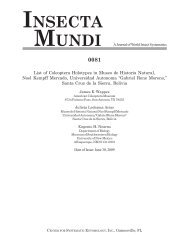
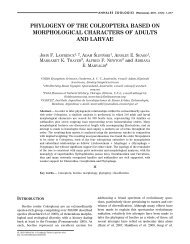


![Coleoptera. Vol. I. [Longicornia. Part I.]](https://img.yumpu.com/41202793/1/180x260/coleoptera-vol-i-longicornia-part-i.jpg?quality=85)
